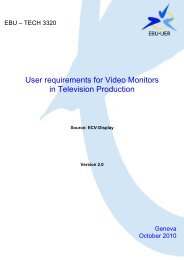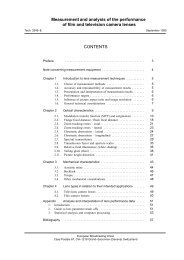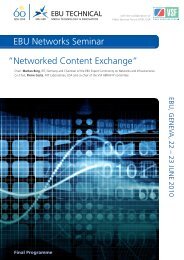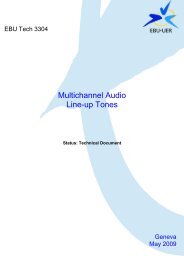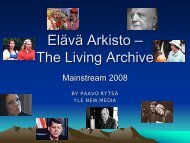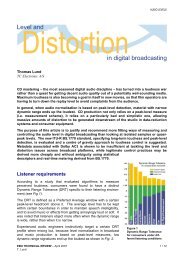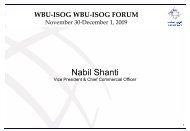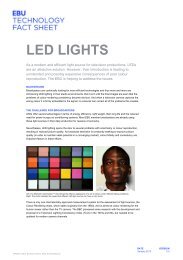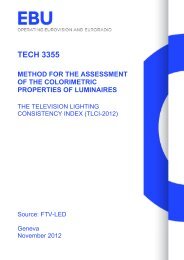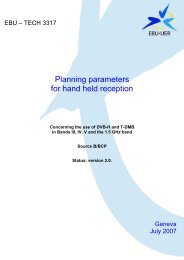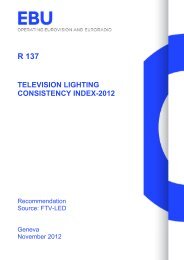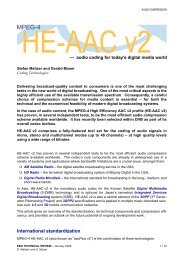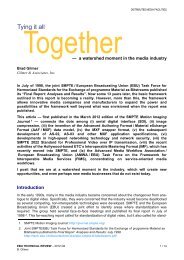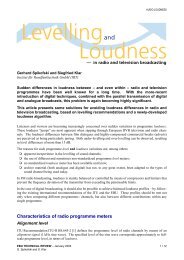Production Technology Seminar 2009 - EBU Technical
Production Technology Seminar 2009 - EBU Technical
Production Technology Seminar 2009 - EBU Technical
You also want an ePaper? Increase the reach of your titles
YUMPU automatically turns print PDFs into web optimized ePapers that Google loves.
Why did we undertake the work?<br />
� The current reference signals are about 30 years old and are based on colour black. They rely on<br />
zero crossings of 3.579545454 MHz and 4.43361875 MHz and require a dedicated infrastructure<br />
� This solution does not support multi-TV standards (e.g. 1080p 50Hz running in the infrastructure with<br />
a sampling frequency of 148 MHz!) and it is not easy to sync Audio and Video. The future digital,<br />
networked and multi-standard media creation and production environments definitely require a new<br />
form of synchronisation signal.<br />
� The current Time Code signal is also about 30 years old and has been many times modified (version<br />
20!) and tweaked,. At the beginning it was designed for linear audio tracks and not for the video. It does<br />
not support frame rates greater than 30 Hz (imagine a system running at 50/60 KHz and even higher in<br />
the future…). It has found many “interpretations” in the market, being implemented by certain<br />
manufacturers in very "individual" ways. The future digital, networked and multi-standard media<br />
creation and production environments also require a new form of time labelling.<br />
At the start of the Task Force project [6], over 100 people subscribed to it, but it came down to a core of<br />
20-30 active parties from broadcast, cable, telcos and users. The TF defined 'User Requirements' (UR),<br />
published then in the form of Request for <strong>Technology</strong>. It got 6 responses from industry, including IPR<br />
(Intellectual Property Rights) declarations. After mapping them against the UR, a first proof of concept<br />
using IEEE1588 (standard for moving a synchronised session over Ethernet - § 2.8) was presented. The<br />
work should be finished in March <strong>2009</strong> and handed over to the SMPTE for standardisation.<br />
2.6 Request for <strong>Technology</strong> & first agreements<br />
Friedrich Gierlinger, <strong>Production</strong> Systems Television, IRT, Germany<br />
A Request for <strong>Technology</strong> was formulated and published (March 2008). The table hereafter lists<br />
examples of User Requirements.<br />
General user requirements<br />
Intellectual property rights<br />
(*)<br />
Respondents to this RFT must declare any patents known or believed to be essential to the<br />
Implementation.<br />
Software platform Users shall be free to make their own software implementations of the standards without<br />
dependence on a particular operating system or hardware platform<br />
Transition to use of the new<br />
standards<br />
The transition from current to new standards should be achieved in broadcast production plant<br />
with infrastructure based on current standards.<br />
Continued availability The proposed technology shall have a high likelihood of continued availability, or availability of<br />
backward-compatible technology, for the foreseeable future.<br />
Basic Value and Economy The proposal should offer significant additional value when compared to the existing colour<br />
black system.<br />
Universal Format Support The synchronization signal must convey sufficient information to generate any appropriately<br />
specified video or audio standard<br />
Deterministic Phasing<br />
between multiple systems<br />
The system must provide deterministic phasing of all current video and audio standards. It must<br />
be able to accommodate potential future standards (e.g. based on arbitrary frequencies) without<br />
change to the synchronization signal.<br />
Frequency reference (*) …A global frequency reference if possible<br />
External lock<br />
The proposal must provide for master generators that lock to an external reference frequency,<br />
and specifically it shall be possible to lock to a global time/frequency reference, such as GPS.<br />
Frequency accuracy and The proposal must support frequency accuracy (at least) sufficient to meet the most stringent<br />
stability (*)<br />
requirements: currently this is the PAL system, requiring accuracy of



